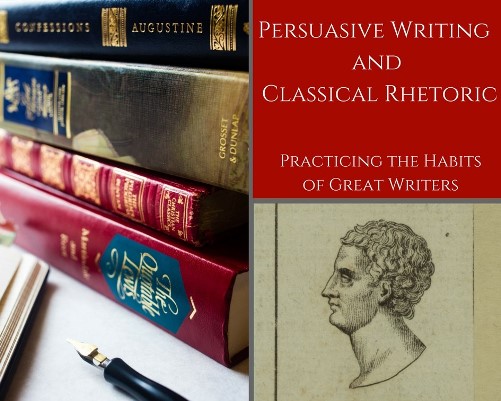I was thrilled to get a chance to review Persuasive Writing & Classical Rhetoric: Practicing the Habits of Great Writers from Silverdale Press LLC intended for students ages 14 to 18.
Other members of the Review Crew got to review White House Holidays Unit Studies intended for ages 5-18 and given the option of an elementary or a junior/senior high school study. These Unit Studies are designed to include 3 to 5 lessons, with each lesson intended to be done in a day. There are activities geared toward K-6 as well as activities geared toward grades 7-12. The unit studies include:
Labor Day - 3 lessons
Veterans Day - 3 lessons
Thanksgiving - 5 lessons
Christmas - 4 lessons with 6 activities per lesson
MLK - 5 lessons
Valentine's Day - 5 lessons
While others were reviewing these unit studies, I got to review a complete comprehensive curriculum on the Persuasive Writing & Classical Rhetoric: Practicing the Habits of Great Writers.
What is the Persuasive Writing & Classical Rhetoric: Practicing the Habits of Great Writers from Silverdale Press LLC?
This is intended for high school level and is a full 36-week curriculum. Students are expected to spend four days per week using it, but there are also instructions on how to use it all 5 days each week. The definition of what rhetoric is, used in this course, describes:
Rhetoric is skillful and artistic communication that aims to persuade an audience
I received this curriculum that comes in 4 parts PDF downloads:
Rhetoric Lesson Book - 235 pages
Rhetoric Reader - 111 pages
Rhetoric Workbook - 202 pages
Rhetoric Answer Book - 65 pages
The idea behind the curriculum is that:
Start with the Lesson Book. The Lesson Book is your guide to the entire program. It will list when to go to the Workbook and when to use the Reader. Either the student or the parent/teacher can then use the Answer Book to check the work, though a lot of the writing has answers that will vary.
Each lesson is set up in the same manner that walks students through reading, thinking, and writing as well as providing pro tips from the writers of the curriculum throughout. The reading passages are in the Rhetoric Reader, and the workbook exercises are in the Rhetoric Workbook. When the students have completed the full 36 weeks, they will have written essays each week as well as completed a final essay. There is a grading rubric included to help the parent/teacher comment and grade the writing.
The only part I had to print were the workbook pages, and honestly I probably could have done these onscreen with the PDF fill-in-the-blank tools. But, I chose to print them.
The course covers excerpts of writings/speeches from:
The last few lessons cover what real writers do, such as pitching your work to an editor and moving beyond rejection.
Rhetoric is skillful and artistic communication that aims to persuade an audience
I received this curriculum that comes in 4 parts PDF downloads:
Rhetoric Lesson Book - 235 pages
Rhetoric Reader - 111 pages
Rhetoric Workbook - 202 pages
Rhetoric Answer Book - 65 pages
The idea behind the curriculum is that:
- Writers Write
- Writers Read
- Writers Think
Start with the Lesson Book. The Lesson Book is your guide to the entire program. It will list when to go to the Workbook and when to use the Reader. Either the student or the parent/teacher can then use the Answer Book to check the work, though a lot of the writing has answers that will vary.
Each lesson is set up in the same manner that walks students through reading, thinking, and writing as well as providing pro tips from the writers of the curriculum throughout. The reading passages are in the Rhetoric Reader, and the workbook exercises are in the Rhetoric Workbook. When the students have completed the full 36 weeks, they will have written essays each week as well as completed a final essay. There is a grading rubric included to help the parent/teacher comment and grade the writing.
The only part I had to print were the workbook pages, and honestly I probably could have done these onscreen with the PDF fill-in-the-blank tools. But, I chose to print them.
The reader include excerpts like this:
- Patrick Henry
- John F. Kennedy
- Winston Churchill
- Wendell Berry
- Ida M. Tarbell
- John Locke
- Daniel Webster
- Alexander Hamilton
- Ronald Reagan
- Thomas Paine
- Augustine
- Thomas Clarkson
- William Wilberforce
- Jane Austin
- Dorothy Sayers
- Martin Luther King, Jr.
- Abraham Lincoln
- Rachel Carson
- Antonin Scalia
- William Strunk and E. B. White
- Henry Watson Fowler and Francis George Fowler
- Sarah Josepha Hale
- Benjamin Franklin
- Eleanor Roosevelt
The last few lessons cover what real writers do, such as pitching your work to an editor and moving beyond rejection.
How Did We Use It?
When I saw this was coming up for review, I knew I had at least one daughter for whom this would fit within their level, but honestly, I was most interested in it for me. I write online, and I am always hungry for refreshers. So, when I got it, I had a choice to make as to who would use it and decided before sharing it with my high schooler, I would dive into it myself.
What Did We Think?
I found this curriculum to be nothing short of amazing! It is extremely comprehensive, including everything you need. It is complete and very easy to follow. I was very impressed at how much thought and work went into putting this curriculum together.




FIND SILVERDALE ON SOCIAL MEDIA @:
Facebook: https://www.facebook.com/SilverdalePress/ Tag: @SilverdalePress
Twitter: https://twitter.com/silverdalepress Tag: @SilverdalePress
Pinterest: https://www.pinterest.com/silverdalepress/
Twitter: https://twitter.com/silverdalepress Tag: @SilverdalePress
Pinterest: https://www.pinterest.com/silverdalepress/
Read what other members of the Homeschool Review Crew thought by clicking on the picture below:











No comments:
Post a Comment